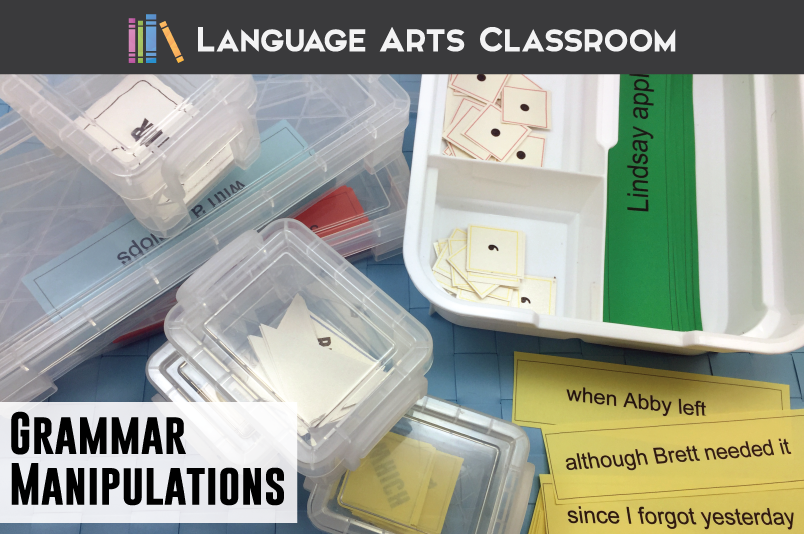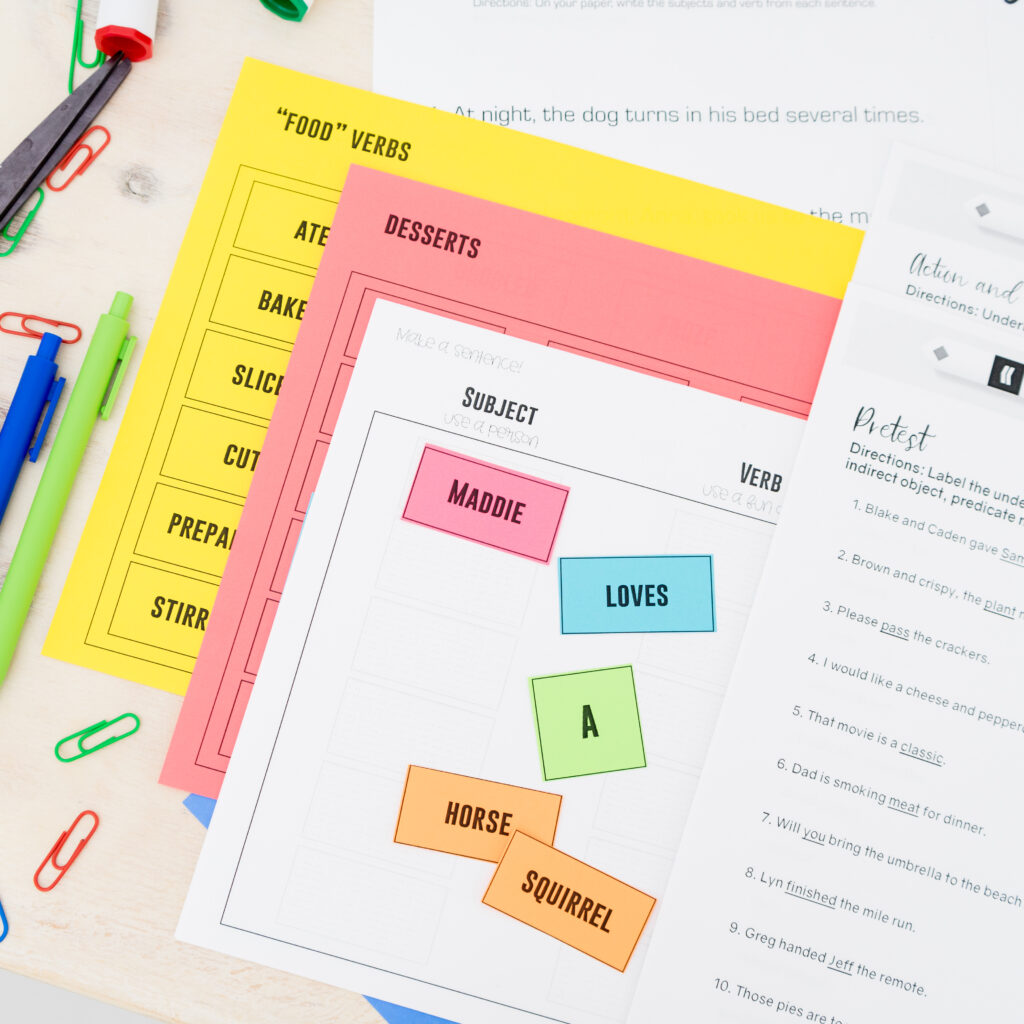Grammar manipulatives: language students can hold. Language arts manipulatives are easy to add to your classroom.
The goal of this is differentiated and scaffolded grammar activity is to allow students to manipulate their language. These grammar activities are not grammar worksheets! My students enjoy holding their language and manipulating it.
I personally have younger kids, elementary age kiddos. To work on math, they have math manipulatives: dice, ten board, fake money, game pieces – the possibilities are endless!
Even my daughter, who will tell me she doesn’t enjoy math, plays with these math manipulatives. She understands math in a unique manner. Her math tools made me think: Could I bring manipulative pieces, manipulations, to grammar?
I wanted to create something. I tried small plastic containers. Then I experimented with wooden blocks. I created different shapes, colors, pictures. I also tried game pieces.
None of it worked quite as well as simple squares of paper that my students could manipulate. Eventually, I printed them all on sturdy card stock.
My kinesthetic students finally had an approach to grammar that they would enjoy. We could change the meaning of sentences, experiment with punctuation, learn sentence patterns, and follow grammar and punctuation rules.
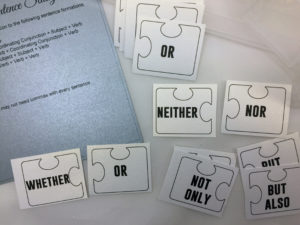
My life passion has turned into making grammar meaningful to students and helping teachers achieve success in teaching grammar. These grammar manipulattives will add a new approach for grammar lessons.
I’m going to describe these grammar manipulatives to show the different ways I use them with students. This grammar activity works in a variety of ways, so you will have some decisions to make for using them with your students.
What is this?!
Language manipulatives are super simple. Each grammar component that you could study (subjects, verbs, clauses, phrases, etc.) need correct punctuation. Students should understand the basics of these components, and as students advance through school, they should (while still using correct punctuation!) manipulate these components. As teachers, we need to give students interactive pieces—pieces they can hold.
I divide mine into different items: 1) punctuation pieces, 2) sentence part pieces (independent clauses, dependent clauses, verbal phrases, prepositional phrases, and 3) conjunction pieces.
To minimize cutting and copying, I bought clear plastic containers at a big box store and after I cut the pieces, gave each section its own box.
I have created multiple files in Powerpoint so everyone can edit them. Whatever you need to study—subjects and verbs, independent clauses and dependent clauses, comma placement, conjunctive adverbs and semicolons—you can do it with this activity.
I use colored card stock with older kids. Other times, I have also laminated them, but after some use, I find that the card stock looks better.
With younger kids, I adhere the printed pages to wood blocks. I have also used the large interlocking blocks. If you have students with special needs, the blocks might help you meet students’ personalized goals.
Decide how you want to differentiate.
With this activity, I attempted to make the differentiation options unlimited.
I have started you off with four different sets of assignments for combining sentences, and then I did four ways to combine simple, compound, complex, and compound-complex. I left these eight sets of directions editable! Delete or add student directions.
For instance, I currently do not have a “subject” and “verb” combination activity, but you have the tools to make them. If you have students who simply need to practice making lists and adding commas with those list, you will be able to do that. Add directions and provide students with coordinating and correlative conjunctions to start them (for example). That would be on the easier end of assignments.
If students need more of a challenge beyond the compound-complex sentence sheet, you could add an “evaluation” component. For example: create different formats with two dependent clauses and an independent clause. Which has the most meaning? Which conveys your message the best? Why? Not only will you be working on punctuation, but you will also be meeting those advanced language standards.
Another option that I have had great luck with is using the students’ writing with this format. When students turn in their papers, I copy and paste a sentence from each paper. Then I differentiate it:
- Some students work on punctuating correctly.
- Another group of students works on building better sentences—sentences beyond an independent clause and many prepositional phrases.
- One or two students practice sentence patterns.
- Some students physically maneuver the components of their sentences. What is the best placement of those phrases? Should some be eliminated? Should the dependent clause be first or second? Should one independent clause be changed to a dependent one?
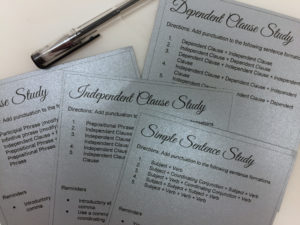
Decide how you want to record the sentences.
Once students practice their sentence, you may want them to capture them.
Options include:
- Take a picture.
- Record in a document (like Google Drive) and share.
- Physically write them on paper.
- Circle the room and record the activity before students continue.
- Glue them to large pieces of paper. (You could also label these and turn them into anchor charts).
Decide if you want to color code.
Honestly, I’ve found that students ignore the color-coding after some time. I begin with color-coding, but you wouldn’t need to label colors.
What worked for me with punctuation pieces:
- Periods: red, stop.
- Commas: yellow, pause.
- Semicolons: green, keep going.
What worked for me with sentence pieces:
- Verbal phrases: orange, fun/ variety.
- Independent clauses: green, they can stand alone.
- Dependent clauses: yellow, pause because you need more.
- Prepositional phrases: blue, neutral.
I did not color code conjunctions. The correlative conjunctions visually appear as puzzle pieces, and my students label coordinating conjunctions as FANBOYS. Since they already had a method, I didn’t feel adding a new component would benefit them. You could, of course, add colors if that helps your students.
Other teachers color-code with envelopes. Then, they simply hand students the needed practice. Some teachers use pieces of tape for labeling.
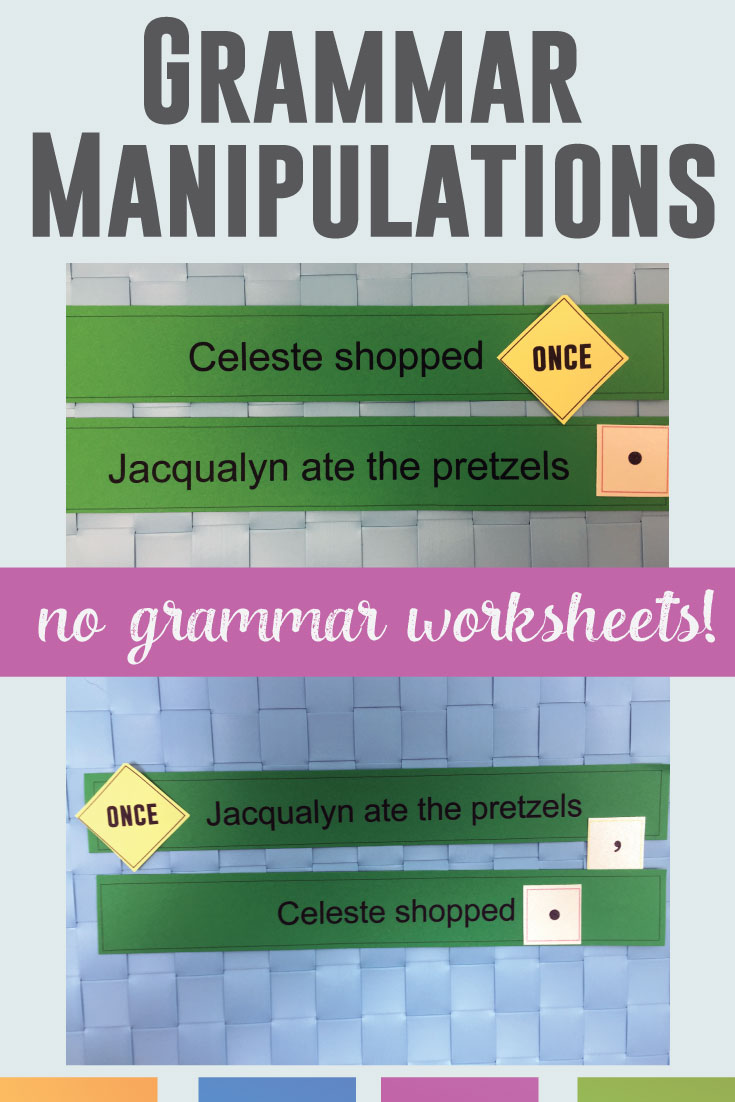
Have fun!
This assignment took me over a year to make because my first vision had blocks—physical (wood) blocks. My older students related to them as babyish, and so I resorted to card-stock and lamination.
Create a fun grammar experience with this! Ask students to create long sentences and punctuate them correctly. Not only will they sharpen their punctuation skills, but they will also learn an important lesson in writing – super long sentences are often difficult to read! Writers use long sentences purposefully.
Encourage the goofiness, but stress that they should keep these activities clean. The sentence pieces (phrases, clauses) are somewhat goofy. Over time, students will build their own, which of course is what we want them to do.
These grammar manipulations brought a non-worksheet activity to my classroom. Students who need to move appreciate the variety. This works well with stations or group work. Even working alone, students can practice grammar skills in a fun way.

